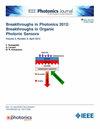室内工业物联网场景下 VLC 的延迟抖动分析
IF 2.1
4区 工程技术
Q3 ENGINEERING, ELECTRICAL & ELECTRONIC
引用次数: 0
摘要
本文分析了可见光通信(VLC)网络中的延迟抖动。首先,研究了单用户和多用户情况下的延迟抖动,得到了闭式表达式,并通过仿真验证了其准确性。其次,通过分析两种典型室内发光二极管(LED)布局下的延迟抖动,我们发现蜂窝布局下的平均用户延迟抖动略低于方形布局。然后,我们研究了移动用户的延迟抖动,以及不同场景下用户移动速度、到达率和延迟抖动之间的关系。假设 VLC 网络采用完美的多点协调(CoMP)传输策略,则对延迟抖动性能进行评估。仿真结果表明,在 VLC 环境下,静态用户的平均延迟抖动可达 10^{-6}$ s,而移动用户的平均延迟抖动可达 10^{-5}$ s。本文章由计算机程序翻译,如有差异,请以英文原文为准。
Delay Jitter Analysis for VLC Under Indoor Industrial Internet of Things Scenarios
The delay jitter in the visible light communication (VLC) network is analyzed in this work. First, the delay jitter under single-user and multi-user scenarios is investigated and a closed-form expression is obtained, whose accuracy is verified by simulation. Second, through analyzing the delay jitter under two typical indoor light emitting diode (LED) layouts, we find that the mean user delay jitter under cellular layout is a little lower than that of square layout. Then, we study the delay jitter for mobile users, and the relationship among user movement speed, arrival rate and delay jitter in different scenarios. The delay jitter performance is evaluated assuming perfect coordinated multiple points (CoMP) transmission strategy in VLC network. Simulation results show that in the context of VLC, static users can experience an average delay jitter of up to
$10^{-6}$ $10^{-5}$
求助全文
通过发布文献求助,成功后即可免费获取论文全文。
去求助
来源期刊

IEEE Photonics Journal
ENGINEERING, ELECTRICAL & ELECTRONIC-OPTICS
CiteScore
4.50
自引率
8.30%
发文量
489
审稿时长
1.4 months
期刊介绍:
Breakthroughs in the generation of light and in its control and utilization have given rise to the field of Photonics, a rapidly expanding area of science and technology with major technological and economic impact. Photonics integrates quantum electronics and optics to accelerate progress in the generation of novel photon sources and in their utilization in emerging applications at the micro and nano scales spanning from the far-infrared/THz to the x-ray region of the electromagnetic spectrum. IEEE Photonics Journal is an online-only journal dedicated to the rapid disclosure of top-quality peer-reviewed research at the forefront of all areas of photonics. Contributions addressing issues ranging from fundamental understanding to emerging technologies and applications are within the scope of the Journal. The Journal includes topics in: Photon sources from far infrared to X-rays, Photonics materials and engineered photonic structures, Integrated optics and optoelectronic, Ultrafast, attosecond, high field and short wavelength photonics, Biophotonics, including DNA photonics, Nanophotonics, Magnetophotonics, Fundamentals of light propagation and interaction; nonlinear effects, Optical data storage, Fiber optics and optical communications devices, systems, and technologies, Micro Opto Electro Mechanical Systems (MOEMS), Microwave photonics, Optical Sensors.
 求助内容:
求助内容: 应助结果提醒方式:
应助结果提醒方式:


